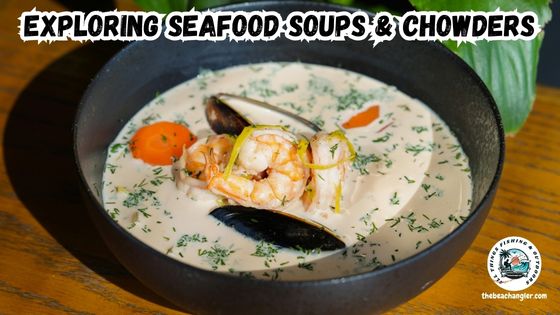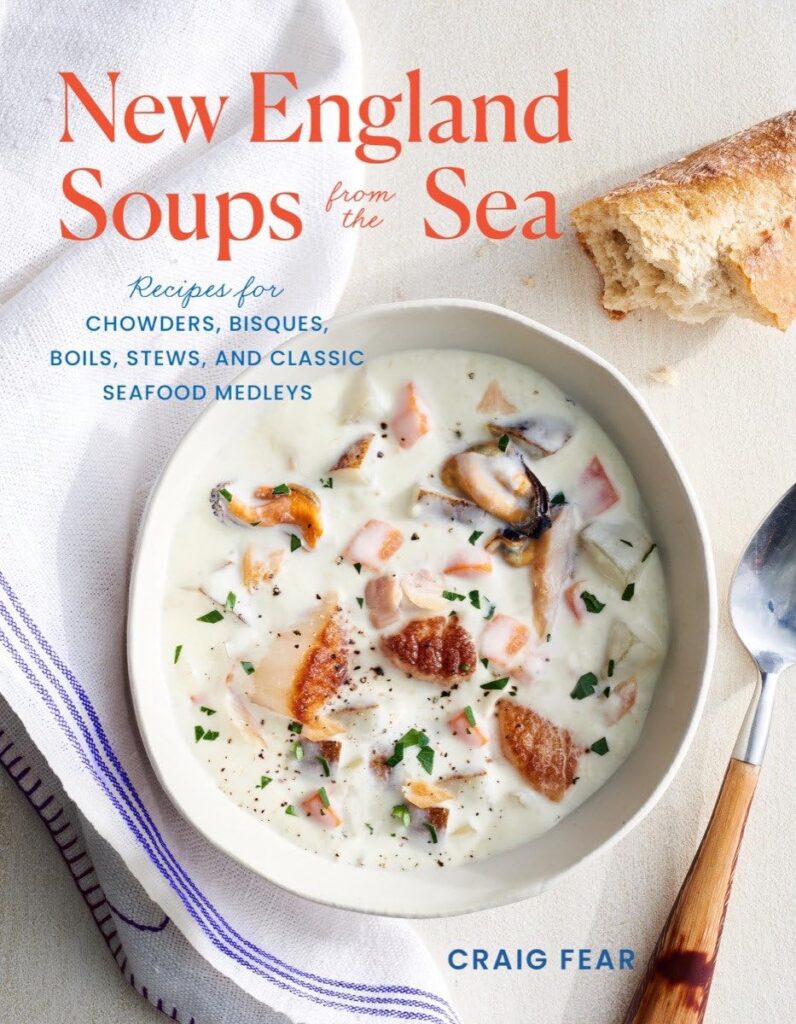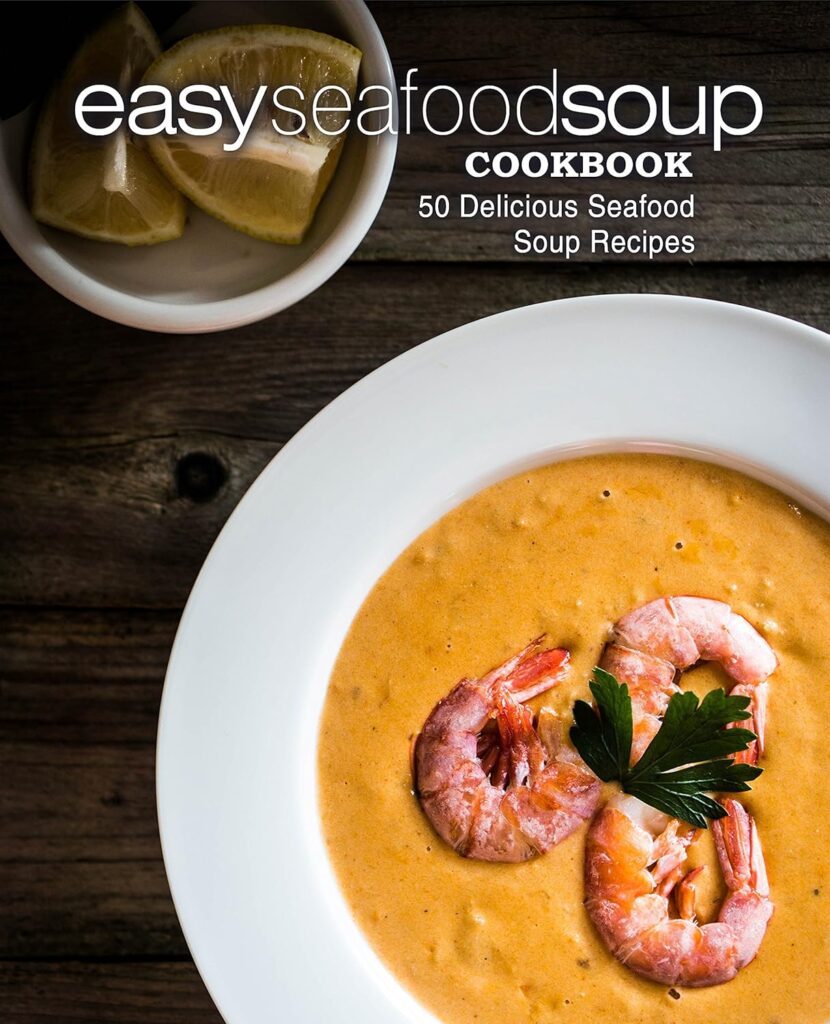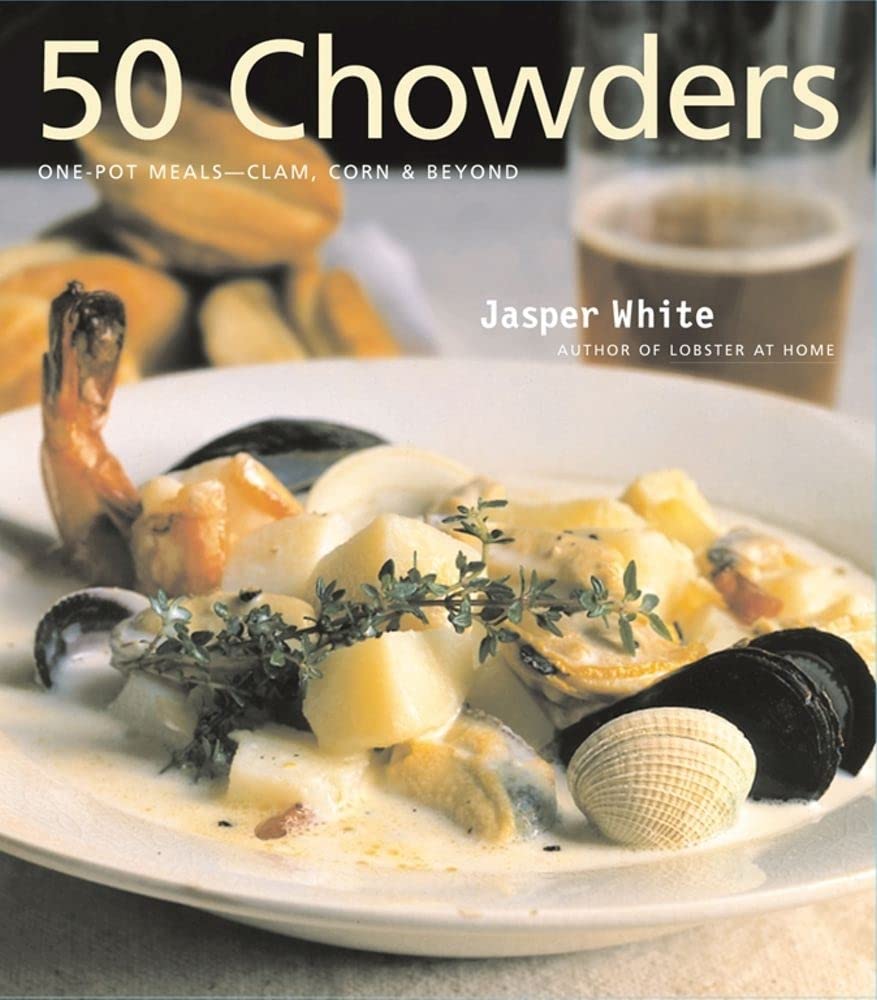You’re catching all these fish and other seafood, now what to do with them? Seafood soups and chowders are both a comfort food and a culinary exploration. I have enjoyed these dishes for a long time and consider them a delightful way to savor the flavors of the sea. In this article, I will walk you through the essentials, techniques, and ideas to create seafood soups and chowders in your own kitchen.
QUICK LOOK: Tips for Seafood Soups and Chowders
- Choose a Base: Select between a clear broth and a creamy base. A clear broth is lighter, while a creamy base makes the chowder richer.
- Fresh Seafood Selection: Use the best quality seafood you can find. Freshness is key to delivering a superior taste in the final dish.
- Simple Vegetables: Start with basic vegetables like onions, celery, and potatoes. These ingredients add texture and depth to the soup.
- Seasoning and Herbs: Basic herbs such as thyme and bay leaves create a subtle but influential aroma. Experiment with these in small doses as you learn the balance of flavors.
- Practice makes perfect: You can begin with one or two recipes and adjust your process each time you make a new batch.
Essential Ingredients for Seafood Soups and Chowders
Many seafood soup recipes start with a flavorful foundation. Broth is at the heart of every good soup. I often use fish stock or clam juice, which provides an authentic taste that makes each spoonful memorable. The choice of seafood is also very important.
Fresh clams, shrimp, and fish not only add protein but also infuse the dish with rich, natural flavors. Complementary vegetables such as potatoes, celery, and onions help the broth develop a balanced taste. Herbs like thyme and bay leaves add an aromatic quality to the soup.
In some recipes, a touch of cream is included to give the chowder a smooth texture. These combining ingredients are often what determine whether a recipe becomes a reliable favorite or just another dinner option.
The essential elements in seafood soups and chowders form the foundation of the dish. A clear understanding of ingredients and their role in the recipe helps beginners and home cooks feel more confident in the kitchen.
I find that knowing these basics makes the cooking process less intimidating and a lot more enjoyable. For those looking to dive deep into the world of seafood soups, it is important to note that sourcing the freshest possible ingredients can make all the difference.
Spending a few extra minutes at your local market or asking your fishmonger for the best catches of the day is a small effort that pays huge dividends in flavor and texture. In addition, learning the subtle interplay between the seafood, vegetables, herbs, and spices can really up your culinary game, whether you are cooking for family or entertaining guests.
Getting Started with Seafood Soups and Chowders
Before gathering your ingredients and heating the stove, understanding the cooking fundamentals is a wise first step. Seafood dishes benefit greatly from timing and careful attention to detail. Some key points to note include the importance of freshness and using suitable preparation methods.
If you are new to cooking seafood soups or chowders, choosing a simple recipe will help you build your skills. I have found that starting with recipes that include pre-prepared stocks and a limited number of ingredients can ease the process. Here are some steps that might help you begin:
- Choose a Base: Select between a clear broth and a creamy base. A clear broth is lighter, while a creamy base makes the chowder richer.
- Fresh Seafood Selection: Use the best quality seafood you can find. Freshness is key to delivering a superior taste in the final dish.
- Simple Vegetables: Start with basic vegetables like onions, celery, and potatoes. These ingredients add texture and depth to the soup.
- Seasoning and Herbs: Basic herbs such as thyme and bay leaves create a subtle but influential aroma. Experiment with these in small doses as you learn the balance of flavors.
- Cook Every Day: Practice makes perfect. Begin with one or two recipes and adjust your process each time you make a new batch.
These steps can help build a solid foundation when preparing seafood soups. Repeating similar techniques allows you to create consistently delicious meals that are tuned to your taste and personal style over time.
Additionally, as you grow more comfortable with your basic recipes, consider testing out small variations like adding a squeeze of lemon or a pinch of smoked paprika to add your personal touch.
It is also helpful to keep a cooking journal where you note what worked well and what could use a little improvement. Over time, you will accumulate a wealth of practical knowledge that will make each subsequent meal feel less experimental and more like a signature creation.
Considerations Before Cooking Your Seafood Soup or Chowder
Every new cooking project comes with its own set of challenges. With seafood soups and chowders, several factors can affect the outcome of your dish. Addressing these points early can help you achieve the best possible results.
- Freshness of Seafood: Fresh seafood makes a huge difference in flavor and texture. Always source your seafood from reputable providers so that you know you’re getting the best ingredients possible.
- Balancing Flavors: It is very important to add only as much seasoning as needed. A little salt goes a long way when it comes to highlighting the subtle notes of the seafood.
- Cooking Times: Seafood cooks faster than most proteins. Overcooking can result in a rubbery texture that undermines the dish’s appeal. Always keep an eye on the clock and step in at the right moment.
- Total Preparation Time: These soups sometimes require a long simmer. Planning your time ahead of the cooking process ensures your meal is ready without unnecessary stress, allowing you to enjoy the entire experience.
Freshness of Seafood
Using seafood that is as fresh as possible is absolutely critical when crafting a soup or chowder. I have learned that even a slight difference in fish freshness can dramatically change the overall taste of the dish. Inspect your seafood carefully and trust your senses when it comes to selecting the best ingredients. Remember, the fresher the catch, the brighter the flavors in your bowl.
Balancing Flavors
Achieving the right balance of flavors involves frequent tasting as you cook. Gradually add salt, pepper, and herbs, and adjust your seasoning to ensure that the final taste is smooth and well-rounded. Finding that perfect equilibrium takes practice, so don’t hesitate to make small adjustments until you are completely satisfied with the flavor profile.
Cooking Times
Seafood tends to lose its tenderness if left in the heat for too long. I usually add the seafood toward the end of the cooking process to avoid this pitfall. This step is really important in preserving a succulent texture and the best natural taste. Always remember that timing is everything when it comes to seafood dishes.
Total Preparation Time
These recipes require a bit of planning since some steps may take longer than others. For example, making your own seafood stock can be a rewarding yet time-consuming process, while chopping vegetables or preparing herbs is relatively quick.
Map out your entire process beforehand to ensure that each component has the proper amount of time to shine. This pre-planning can also add a meditative quality to cooking, allowing you to truly appreciate each step.
Understanding these practical considerations ahead of time prepares you to handle the entire process with confidence. Every factor, from the crispness of fresh produce to the careful addition of seasoning, plays its part in producing a dish that is both delicious and satisfying.
Advanced Tips and Tricks for Creating Exceptional Seafood Soups and Chowders
Once you are comfortable with the basics, you may begin to experiment and refine your cooking skills further. I have stumbled upon that a few advanced techniques can lend a professional touch to your dish. These next-level ideas are all about fine-tuning your flavors and textures to create a meal that stands out.
Experiment with Spices: Aside from salt and pepper, spices such as paprika or a dash of cayenne can add a subtle kick without overwhelming the natural flavors of the seafood. A careful balance can make the dish more engaging, and adding a hint of spice might even bring an unexpected twist to your traditional chowder.
This not only brings a deeper dimension to the flavor profile but also makes the overall eating experience more memorable. Consider testing one spice at a time to see how it interacts with the other ingredients. It might surprise you how a small amount of heat or smokiness can kick things up a notch.
Selecting the Right Texture: Texture is an important part of any chowder. I try to maintain a balance by keeping chunks of vegetables intact while ensuring the broth stays smooth. Techniques such as partially mashing the potatoes help in achieving a creamy consistency, which in turn complements the firm texture of the seafood.
The contrast between crunchy vegetables and tender seafood creates a delightful eating experience. Experiment with different cutting techniques and cooking times to find the texture you prefer most.
Advanced Broth Preparation: Making your own seafood stock using leftover shells and bones can intensify the flavor profile in a way that store-bought versions rarely achieve. This homemade base is often richer and more nuanced. To make such a stock, simmer the seafood shells with a mixture of vegetables, herbs, and a splash of white wine.
It might take a bit longer to prepare, but the robust results are definitely worth the extra effort. This approach not only deepens the overall flavor but also gives you the satisfaction of creating something truly homemade.
These advanced tips help switch up your dish from a simple meal to one that leaves a lasting impression on your palate. When combined with the basics, they create a balance that is both comforting and surprisingly innovative. Remember, experimentation is key, and every attempt is a valuable chance to refine your skills further.
For those looking to push the boundaries even more, consider incorporating international twists into your recipes. Adding elements like a splash of coconut milk or a dash of lemongrass can transport this classic dish into a completely new culinary realm. The possibilities are endless when you let your creativity fly and treat each meal as a canvas for experimentation.
The Basics: What Ingredients Should Beginners Focus On?
Just as a painter gets started with a basic palette, a cook working on seafood soups needs a reliable set of ingredients. I have found that starting with recipes that require fewer ingredients makes the learning process smoother and less stressful. By focusing on a select few high-quality elements, you can let each ingredient shine without unnecessary competition on the plate.
Simple ingredients do not mean a lack of flavor. Basic ingredients support the natural qualities of seafood and vegetables without adding unnecessary complications. In everyday cooking, they help maintain the authentic character of the dish and serve as a solid foundation upon which you can build as you gain confidence in the kitchen.
- Seafood Variety: Rely on widely available seafood like clams, shrimp, and firm white fish. These proteins work well together and support the overall taste balance, ensuring every bite is satisfying.
- Vegetable Essentials: Onions, potatoes, and celery are staples when forming a hearty base. They not only add texture and body to the soup but also bring a subtle sweetness that complements the briny seafood flavors.
- Herbs and Spices: A few key herbs like thyme and bay leaves, along with a modest amount of seasoning, give a boost to your broth without overpowering its natural essence.
Using a limited set of ingredients allows you to focus on perfecting your technique and understanding each element’s impact on the final dish. Once you are comfortable with the basics, feel free to mix in additional components such as a splash of white wine, finely chopped parsley, or even a spoonful of tomato paste to add complexity. Experimenting with new elements gradually is the best way to develop your own distinctive style.
It may also help to research regional variations in seafood soups and chowders. Many coastal communities have their own unique takes on these dishes, shaped by local ingredients and traditions. By exploring these variations, you can pick up subtle techniques and flavor combinations that elevate your own cooking to a truly personal art form.
Frequently Asked Questions
Below are some questions that I often encounter when discussing seafood soups and chowders with fellow food enthusiasts. I’ve taken the time to answer these questions in detail to help you feel more comfortable when attempting these recipes at home.
What factors are most important when selecting seafood for soups?
Freshness and quality are essential. I recommend choosing seafood from reliable sources. It is best to use ingredients that are in season and have been stored properly. By paying close attention to these details, you ensure that every spoonful of your soup delivers the robust flavors of the sea.

Can I make a seafood chowder without cream?
Yes, you can. There are many variations of chowders that use alternative thickeners such as blended vegetables or oatmeal. This method offers a lighter option without sacrificing texture, while still providing a satisfying richness to the dish.
How do I avoid overcooking the seafood?
I typically add my seafood towards the very end of the cooking process. This method prevents the seafood from becoming tough and ensures it retains its natural tenderness, which is really important when it comes to preserving that fresh, delicious flavor.
Is it necessary to make homemade seafood stock?
While homemade stock can step up the flavor significantly, high-quality store-bought options work well too. It depends on the time you are willing to invest and the specific taste you are aiming for. For those looking to experiment further, creating your own stock can be a fulfilling process that lays the groundwork for a truly next-level cool dish.
Wrapping Up Seafood Soups and Chowders
Creating seafood soups and chowders at home can be both a delightful and enriching experience. The process starts with choosing the best ingredients and understanding the role each component plays in the final dish.
I have learned that the best recipes balance simplicity with a careful approach, ensuring that every spoonful bursts with the natural taste of the sea. From deciding on the perfect broth to mastering the art of timing, every step is part of a larger process that leads to a satisfying meal.
The wonderful variety of seafood available allows each dish to tell its own story. This opens up an adventure of flavors and aromas that reflect the bounty of the ocean while also inviting you to test out creative twists.
If you are new to seafood soups and chowders, start with the basics and gradually incorporate advanced techniques as you gain confidence in your cooking. Every dish you prepare is an opportunity to grow as a cook, and each recipe brings with it lessons that you can build on over time.
Keep refining your methods, note the differences in taste when you adjust ingredients, and most importantly, enjoy the creative process. In addition to the practical cooking advice, consider exploring the history and regional variations of these dishes.
Learning about the origins of chowders or the traditions behind seafood soups in coastal cultures can add depth to your appreciation and even influence your own recipes. This extra research can serve as inspiration when you are ready to experiment and make the dish your own.
Always remember that cooking is an art form that evolves with every meal you make. With a little patience, a willingness to experiment, and an eye for detail, you can create seafood dishes that are as gratifying to prepare as they are to eat.
So gather your ingredients, follow these detailed guidelines, and let your creativity run wild in the kitchen. Enjoy the adventure of exploring seafood soups and chowders. With care, persistence, and a bit of creative spirit, you are well on your way to making impressive meals that bring comfort and joy to every table. Happy cooking!
Check Out Our Most Recent Articles:
- Using a Personal Watercraft For Saltwater Fishing

- 5 Advantages of the Penn Squall Low Profile Baitcasting Reels

- Electronic Fish Finders For Kayak Fishing

- What’s New From ICAST 2025

- 5 Budget-friendly Saltwater Fishing Kayaks For Beginners

- 12 Tips for Fishing Baffin Bay, Texas

As always, stay safe, enjoy the journey, and please try to leave it cleaner than you found it. If you have any comments, questions, ideas, or suggestions, please leave them in the comment section below, and I’ll get back to you ASAP. You can follow us on Facebook: Rex The Beach Angler, Instagram: thebeachangler7, Twitter: @AnglerBeach, and YouTube: Man Art Creations.
P.S. Thanks so much for checking out our blog; we really appreciate it. Just so you know, we may receive a commission if you click on some of the links that appear on our site. This helps us keep our content free and up-to-date for everyone. We appreciate your support!

A life long surf fisherman with 50+ years of experience, I am also an avid hunter and outdoorsman. I will be sharing my passion for the outdoors with you so be prepared for hunting, fishing, camping, hiking and more. Along with gear reviews and the latest trends and innovations in the outdoor industry.






